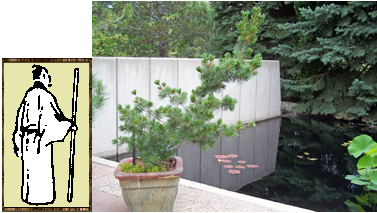
Hexagram Forty-three—Removing Impurities
The metaphor is a weak-minded or corrupt statesman on trial. In this case, the prosecutor's own good character wins over the judge.
The first line, yang, shows a prosecutor trying to advance their case simply by movement of the toes. This is not enough effort and there will be misfortune.
The second line, yang, shows the prosecutor fearful and sincerely appealing for justice. This person is vulnerable, and although people may come in the night to cause problems, there is no reason to fear.
The third line, yang, shows one who tries to make a case by threatening the court. This will lead to misfortune. Another person works hard to gather evidence. This person may encounter difficulty, including the ridicule of colleagues, but their determination will bring success.
The fourth line, yang, shows one who walks with great difficult after a flailing cuts the skin of their buttocks. It would be wise for this person to walk as a sheep among the herd for now, but pride will not allow them to listen to such advice.
The fifth line, yang, shows a prosecutor going after the criminal class as they would uproot a bed of weeds. This determination is appropriate and will lead to good fortune.
The sixth line, yin, shows a prosecutor who attempts a difficult project without any help. This is unfortunate and will not lead to success.
Hexagram Forty-three Commentary
This hexagram explains how to remove impurities within a system. The introduction gives the ultimate example of how it's done. If there is a corrupt politician on trial, and the prosecutor has a sterling reputation, then "the prosecutor's own good character wins over the judge." The lines of the hexagram show different ways to approach such impurities that will or won't work, and why.
The first line, yang shows a prosecutor who can't make a good case. The metaphor is the prosecutor is trying to argue the case "simply by movement of the toes." It's not convincing.
The second line, yang, is a case where the prosecutor is genuinely fearful of impure elements, and gets the message across. This could be dangerous if those accused "come in the night to cause problems," but the advice is to be courageous because "there is no reason to fear."
The third line, yang, first offers an example of the wrong way to make a case: the prosecutor tries to threaten the court. Next, the correct way: the prosecutor works hard to gather evidence. This shows the bully offense against the court will fail, but the diligent person who works hard to make a case will succeed.
The fourth line, yang, shows an arrogant prosecutor who got his bottom kicked, who comes back for more. The line describes it as "one who walks with great difficulty after a flailing cuts the skin of their buttocks." The advice is to "walk as a sheep among the herd for now," in other words, be humble, don't act like you're better than everyone else. However, due to arrogance, a person may ignore good advice.
In the fifth line, yang, the prosecutor goes after criminals like pulling weeds from a garden. This is appropriate.
In the sixth line, yin, the prosecutor tries too hard to manage a difficult case with no help. This will lead to defeat. The message is to bring in needed support when working on a big project.
To the reader: Most of the hexagrams have at least one line that predicts bad results, but that does NOT mean you are fated to that result. The hexagrams illustrate different attitudes, so study the actions and reactions to learn the attitudes that will lead to better outcomes.
The I Ching teaches you to flow with changes and create positive change from the inside through conscious living. Your future is in your hands. Consult the I Ching for ideas that lead to clear thinking and positive mental attitude. Reading the I Ching helps you take the time to reflect on your attitudes and ideas. Continue asking until you feel positive about your course.

Click here for another hexagram.
A note about this interpretation of the I Ching: Nori Muster wrote this version of the I Ching in 1994 and put it online at Surrealist.org in 2000. It is also available at Amazon:
e-book
paperback
